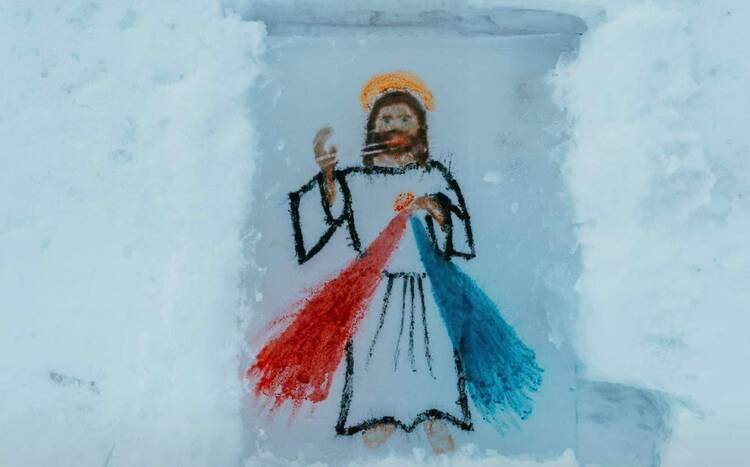When winter regularly throws you more than 200 inches of snow, make an ice chapel.
That was the decision of a group of students at a northern Michigan engineering school back in 2016, when the Rev. Ben Hasse decided to capitalize on Michigan Technological University’s winter carnival week. The carnival features an ice sculpture building contest in which students have one night to create the statue. Dozens of Michigan Tech students who are also part of St. Albert the Great University Parish entered the contest in 2014, but their sculpture did not place. But the next year’s theme, vacation, gave students a bit more creative flexibility. They decided to carve St. Peter’s Basilica—and ended up winning the contest.
Things escalated from there, and by 2016, the idea for the ice chapel was born.
When winter regularly throws you more than 200 inches of snow, make an ice chapel.
“It just seemed like this really cool opportunity to do something that was catching people’s imagination, that was going to be positive and faith filled,” Father Hasse told America.
Construction of the ice chapel is student-led and provides an opportunity for fellowship and even faith sharing.
Daniel LaCroix, who graduated in 2018, served as the unofficial architect of the chapel when he was a student at Michigan Tech. He explained that forms for the ice bricks are made from two pieces of plywood, about four by eight feet, held together with braces. Students shovel snow into the boxes, which is then stomped down tight. The wood is removed and an ice brick is formed. That process is repeated again and again as the chapel, located in the church parking lot, takes shape.
The whole process takes weeks and involves dozens of students. The work continues right up to the first celebration.
“It’s usually finished within an hour or two of the ice Mass,” said Mr. LaCroix, who is now studying to be a priest.
Following the success of the first ice chapel in 2016, each subsequent iteration included more embellishment. An altar was made from ice cut from Lake Superior. To encourage social distancing last year, students built snow pews. Acoustics are challenging, as the student engineers have yet to figure out a safe way to build a roof to capture sound. To help, they built a raised pulpit to help sound travel farther. There are even stained-ice windows.
Madi Hollman is a chemical engineering graduate student at Michigan Tech. This year, she is again helping to create some of the windows. Some of the windows are made with ice blocks painted with water colors while others mimic mosaics. Food coloring is used to dye water, which is frozen into panes, shattered to create small pieces of colored ice and then used to create different patterns and images. Past creations have included windows depicting Our Lady of Guadalupe, the Sacred Heart of Jesus and a depiction of the Holy Spirit as a dove. It takes a couple of days for the panes to freeze and the dozen or so windows measure about 14 by 30 inches. A larger one is made to place behind the altar.
Ms. Hollman said there is something spiritual in the labor she and the other students put into creating the chapel.
“When you’re spending time that maybe you should be using for studying or other things, instead you’re ironing a pane of ice, you think about the beauty that it’s going to create,” she said. That work gives her the time to reflect on the “people that come to these Masses and the importance of beauty and how that lifts you to think about God.”
As for the first evening Mass in the ice chapel, the forecast calls for a temperature of about 12 degrees—with a 50 percent chance of snow.
Holding a Mass outdoors in the middle of winter can present challenges. Father Hasse said his lips have stuck to frozen chalices on more than one occasion, and Ms. Hollman said it is important for students to warm up in between last minute touch ups to the chapel and the start of Mass. And Father Hasse said that while the Masses themselves are unique and moving, the construction of the chapel is the real point.
“Students show up to come and help build, they bring their friends, and by the end of that process, there are people that we had never met that are now and are really part of the community,” he said.
Though people tend to focus on the novelty of the ice chapel, Father Hasse said the true fruits of the labor will be known only decades from now.
“Over the course of the next 50 years, what really matters are the students who maybe weren’t real connected to the faith and then this was a starting point,” he said. “That’s the thing that I’m the most excited about.”
A handful of Masses will be celebrated in the structure, dubbed the Ice Chapel of Our Lady of the Snows, beginning Feb. 11, and will be livestreamed. One will be celebrated by candlelight, the flames bouncing off the walls and illuminating the stained-ice windows. Masses will continue for as long as the structure remains frozen, or until the parish needs its parking lot back.
As for the first evening Mass in the ice chapel, the forecast calls for a temperature of about 12 degrees—with a 50 percent chance of snow.







